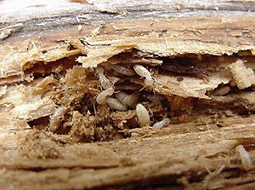TERMITES - WHITE ANTS
ALLHART Pest Management provide termite treatment methods tailored to individual requirements for the prevention and eradication of termites.
Termites are small, soft-bodied, social insects, commonly known as white ants, but are not related to true ants.
There are over 2300 species of termites of which about 350 occur in Australia, and of these about 20 damage sound timber. Termites recycle organic materials and aerate the soil and are an important part in the diet of some animals with their activities providing hollow logs, used by birds and mammals.
Subterranean Termites are the most destructive kind of termite. They can cause a lot of expensive damage to a structure. They can destroy building foundations, wooden support beams, plastic plumbing pipes, sub-flooring, insulation, swimming pool liners and filtration systems and can also injure or destroy living trees and shrubs.
 Conditions conducive to termite attack include:
Conditions conducive to termite attack include:
- Inadequate sub-floor ventilation
- Presence of excessive moisture
- Untreated or non-durable timber used for construction and/or stored in or around a structure
- Bridging or breaching of any component of a termite barrier system and/or insufficient slab edge exposure
- Material built up or stored in or around structures, this may include soil, wood or any product containing cellulose, etc.
Signs of termite attack include:
Blistering of timber surfaces, paintwork or varnishes etc.
Built up areas of moisture
Mud tunnels/leads
To protect your property against termite attack it is important to have a termite prevention program in place and regular inspections of all accessible timber and potential termite entry points. If you find signs of termites do not disturb them as this will complicate the problem and lessen the effectiveness of any treatment.
An ALLHART Pest Management Termite Inspection includes a visual inspection of the following areas (where readily accessible):
Sub-Floors
- All subfloor areas including foundation walls, piers, behind plumbing pipes, loose timbers, builder's debris and stored materials.
- Timbers such as bottom plates, base plates, bearers, joists and the underside of flooring and all other timbers especially those close to plumbing and drains.
- Timbers in contact with soil, such as stumps, posts and formwork or any other cellulose containing material.
 Interior Areas
Interior Areas
- Interior walls, ceilings, partitioning, stairways, flooring, skirting boards, cupboards and timbers around windows and doors.
- Behind plumbing and around pipe penetrations through slab-on-ground construction with particular attention paid to all timbers adjacent to plumbing or plumbing fixtures.
- Fireplaces.
Roof Space:
- Timber roof truss members and roof framing including rafters, ceiling joists, ridgeboards and purlins
- Top wall plates and accessible roof or wall juncture (eaves) timbers.
- Roof lining, around air conditioning units and water heaters.
Exterior Areas

- Eaves, window and door frames and walls, noting excessive moisture and probable causes such as defective drainage, plugged or damaged gutters and inadequate ventilation or sealing against moisture.
- Slab edges including any cracks and expansion joints.
- Timber that rests on or extends into concrete or soil such as supporting posts on decks.
- Paths and driveways abutting the building.
- Stairways, decks, handrails.
- Rafters such as those in the carport or garage that protrude from the roof or eaves area.
- Landscaping timbers, fences, logs, pool surrounds, firewood, paving blocks and sleepers.
- Trees and stumps


